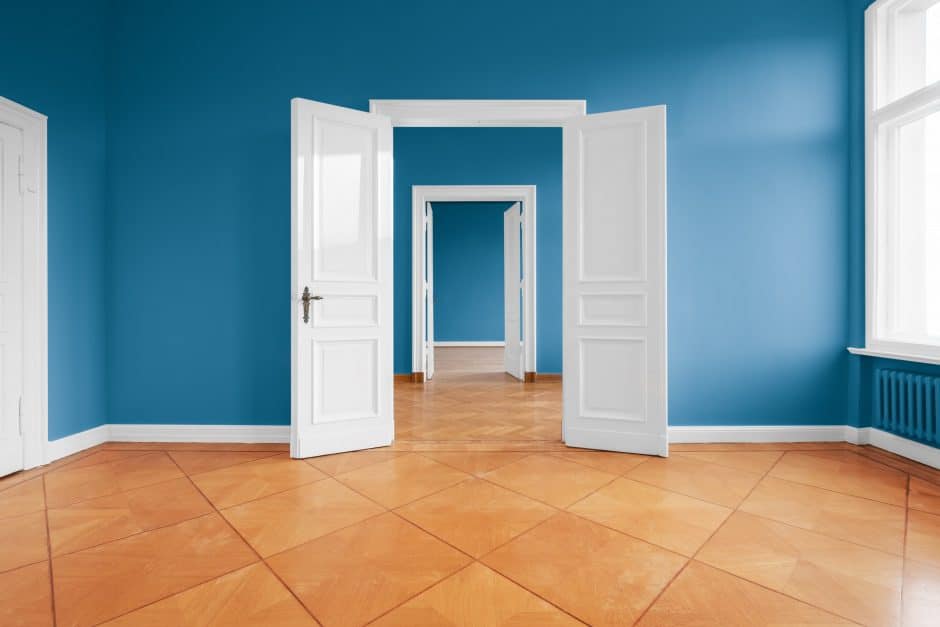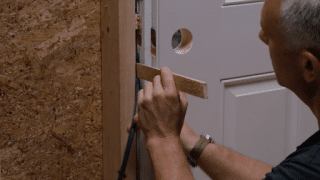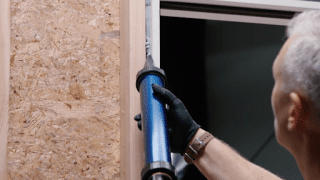
Whether they’re in a residential home or a commercial building, doors play an important role in the overall design of the structure. Not only do they serve as barriers for security and safety, but they’re also a huge part of the building’s aesthetics. With so many types of doors to choose from, a designer will often take quite a bit of time to choose just the right one.
12 Common types of doors
The following are some of the most common types of doors. Note that all of these doors are available in a variety of materials, such as wood, glass, aluminum, steel, or a combination of each. Some doors might actually be a mix of two or more categories or styles.
1. Hinged doors
Hinged doors are the most common type of passage door in homes, offices, commercial buildings, and other structures. These doors hang from a set of brackets held together with pins. The pins allow the doors to pivot and swing open and close. Lighter doors might require just two hinges, while heavier doors might require three or four. Hinged doors come in a variety of materials and styles.
2. Sliding doors
Sliding doors hang from or sit inside a track, and glide left or right rather than swing in or out. Common places to find sliding doors are closets (where hollow wood doors or glass doors covered with mirrors are popular) or exterior openings between living spaces and porches or decks (typically fiberglass and glass).
3. Double doors
The double door category includes many doors consisting of two side-by-side hinged doors that meet in the middle of a frame. These doors can include French-style doors full of glass, or wood doors separating a formal living room from a dining room.
4. French doors
Many folks confuse French and double doors to be one and the same, however, they’re not. French doors do not necessarily need to be double doors, though many are. Instead, French doors are swinging, hinged doors with glass panels from top to bottom. They can consist of 6, 8, 9, 12, or 15 panes (known as “lights”), or one large panel of glass.
5. Pocket doors
In many older homes, pocket doors separated interior spaces. These doors operate like sliding doors, except that they glide within the wall. This gives the home a way to separate a space effectively without giving up floor space for a hinged door’s outward swing. These were common features separating dining rooms, bathrooms, pantry spaces, and other areas within older homes. These doors can be double or single, but they’re most commonly wood.
6. Dutch doors
A common feature in many farm homes, dutch doors were common exterior doors in kitchens. This door style consists of two separate top and bottom doors that swing independently of each other, yet can latch together with hardware to create one door. In practical use, the resident would latch the lower door while leaving the top door open for airflow and light. These doors are typically wood and simple in design.
7. Pivot doors
There’s a type of swinging door that doesn’t utilize typical hinges, and they’re known as pivot doors. These doors sit atop a pin protruding from hardware in the floor, while another pin in the top of the jamb drops into a recess in the top of the door. The door pivots on those pins, creating a smooth, sleek opening action. These doors are typically wooden but can be steel in commercial settings.
8. Bifold doors
For many closet openings and passageways between casual living areas, bifold doors are a popular choice. Rather than only swinging on hinges or simply sliding back and forth, these doors are a combination of both. These doors consist of two thinner doors attached with a hinge in the middle. One door is anchored in place, while the other rides in a track like a sliding door. As the door opens, the hinged edge swings into the room while the sliding edge slides toward the anchored edge, folding the door in half. This allows for a large door opening to take up less floor space with the door open.
Whether they’re in a residential home or a commercial building, doors play an important role in the overall design of the structure. Not only do they serve as barriers for security and safety, but they’re also a huge part of the building’s aesthetics. With so many types of doors to choose from, a designer will often take quite a bit of time to choose just the right one.
12 Common types of doors
The following are some of the most common types of doors. Note that all of these doors are available in a variety of materials, such as wood, glass, aluminum, steel, or a combination of each. Some doors might actually be a mix of two or more categories or styles.
1. Hinged doors
Hinged doors are the most common type of passage door in homes, offices, commercial buildings, and other structures. These doors hang from a set of brackets held together with pins. The pins allow the doors to pivot and swing open and close. Lighter doors might require just two hinges, while heavier doors might require three or four. Hinged doors come in a variety of materials and styles.
2. Sliding doors
Sliding doors hang from or sit inside a track, and glide left or right rather than swing in or out. Common places to find sliding doors are closets (where hollow wood doors or glass doors covered with mirrors are popular) or exterior openings between living spaces and porches or decks (typically fiberglass and glass).
3. Double doors
The double door category includes many doors consisting of two side-by-side hinged doors that meet in the middle of a frame. These doors can include French-style doors full of glass, or wood doors separating a formal living room from a dining room.
4. French doors
Many folks confuse French and double doors to be one and the same, however, they’re not. French doors do not necessarily need to be double doors, though many are. Instead, French doors are swinging, hinged doors with glass panels from top to bottom. They can consist of 6, 8, 9, 12, or 15 panes (known as “lights”), or one large panel of glass.
5. Pocket doors
In many older homes, pocket doors separated interior spaces. These doors operate like sliding doors, except that they glide within the wall. This gives the home a way to separate a space effectively without giving up floor space for a hinged door’s outward swing. These were common features separating dining rooms, bathrooms, pantry spaces, and other areas within older homes. These doors can be double or single, but they’re most commonly wood.
6. Dutch doors
A common feature in many farm homes, dutch doors were common exterior doors in kitchens. This door style consists of two separate top and bottom doors that swing independently of each other, yet can latch together with hardware to create one door. In practical use, the resident would latch the lower door while leaving the top door open for airflow and light. These doors are typically wood and simple in design.
7. Pivot doors
There’s a type of swinging door that doesn’t utilize typical hinges, and they’re known as pivot doors. These doors sit atop a pin protruding from hardware in the floor, while another pin in the top of the jamb drops into a recess in the top of the door. The door pivots on those pins, creating a smooth, sleek opening action. These doors are typically wooden but can be steel in commercial settings.
8. Bifold doors
For many closet openings and passageways between casual living areas, bifold doors are a popular choice. Rather than only swinging on hinges or simply sliding back and forth, these doors are a combination of both. These doors consist of two thinner doors attached with a hinge in the middle. One door is anchored in place, while the other rides in a track like a sliding door. As the door opens, the hinged edge swings into the room while the sliding edge slides toward the anchored edge, folding the door in half. This allows for a large door opening to take up less floor space with the door open.
9. Barn doors
Barn doors are another style of sliding door. They get their name for operating in the same fashion as doors on a livestock or farm barn, sliding side to side on heavy-duty bracketry. They’re popular in modern farmhouse decor, and they’re often found separating pantries and other areas that don’t need ultimate security but a stylish barrier instead. When fully open, they expose the entire width of the door jamb like a pocket door, but because they don’t slide into the wall, they require clear wall space free from shelves or furniture.
10. Battened and ledged doors
Similar to barn doors, battened and ledged doors are a rustic style common in farm-style homes and cabins. These doors consist of vertical battens attached to horizontal ledges. They often feature a diagonal support stretching from one ledge to the other. Batten and ledged doors are almost exclusively made from wood.
11. Panel doors
By far the most popular door style, panel doors consist of frames made from rails and styles, with panels in between. The frame provides the structure and support, while the panels provide style and aesthetics. In most modern applications, these doors aren’t actually separate pieces, but one sheet of fiberboard or fiberglass stamped and molded to appear as panels. These doors are popular as exterior and interior doors of all types.
12. Front doors
While there are a variety of different styles and materials used, front doors can technically be a category of their own. These exterior doors are generally made from wood, fiberglass, or steel, and they’re insulated against the weather and reinforced for security. They might feature additional wings on either side of the door known as “sidelights,” and they can even come in double-door styles.
MT Copeland offers video-based online classes that give you a foundation in construction fundamentals with real-world applications, like installing windows and doors. Classes include professionally produced videos taught by practicing craftspeople, and supplementary downloads like quizzes, blueprints, and other materials to help you master the skills.






